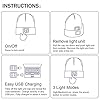YunTuo LED Beanie with The Light, Unisex USB Rechargeable Headlamp Winter Knitted Cap Gifts for Men Dad Husband Him
7% OffMELASA Unisex Hat with Light, USB Rechargeable Hands Free Headlamp LED Beanie, Winter Gifts for Men Dad Father Husband Him
$12.99 (as of December 18, 2025 04:22 GMT +00:00 - More infoProduct prices and availability are accurate as of the date/time indicated and are subject to change. Any price and availability information displayed on [relevant Amazon Site(s), as applicable] at the time of purchase will apply to the purchase of this product.)Rucking and hiking are two popular pastimes and modes of exercise consisting of long-distance walking over extended periods. While they share obvious similarities, rucking and hiking have distinct differences when it comes to equipment, muscle activation, difficulty level, and overall outcomes.
If you are debating getting into recreational walking activities and curious whether rucking or hiking is better for your needs and preferences, this guide explores the key comparisons including pros and cons. After detailing what each activity entails along with requirements, we’ll directly contrast them to help decide which aligns better with your goals.
Key Facts: Rucking
Rucking involves completing long treks over miles of terrain outdoors while carrying a loaded backpack, typically containing heavy weight in the form of training plates, sandbags or loaded bladders. The goal is to walk as far as possible within a given time or until muscular fatigue sets while bearing the extra load.
Key Attributes:
- Outdoor walking with heavy backpack
- Promotes muscular endurance
- Burns high calories
- Low-impact cardio & strength
Essential Gear:
- Heavy backpack (25+ lbs load)
- Distance tracking method/app
- Loading weights – plates, sandbags, etc
Common Distances:
- 3-15 Miles+
Pace
- 12-15 minute miles or faster for intensity
The continually increasing heart rate and accumulating lower body stresses make rucking an extremely demanding yet accessible workout drawing enthusiasts from fitness walks to special forces.
Now let’s explore hiking and how it compares.
Key Facts: Hiking
Hiking involves walking outdoors over extended distances on trails and paths through nature. While variable based on terrain, a common definition of recreational day hiking spans 5+ miles. The goal is to immerse yourself in the outdoors, with exercise being a secondary benefit.
Key Attributes:
- Walking outdoors for exploration
- Varying distance goals
- Escape urban environments
- Lower intensity pacing
Essential Gear:
- Comfortable shoes/boots
- Weather appropriate clothes
- Map, safety kit, phone
Common Distances:
- 5-15 Miles
Pace
- 1-2 Miles Per Hour
Casual hikers simply enjoy meandering through nature. Yet long expeditions also push human endurance like thru-hiking epic trails. These extremes contrast the intensity approaches of rucking.
Now that we’ve outlined both walking practices separately, let’s directly compare them across key attributes.
Weight Carried Comparison
The defining equipment difference between hiking and rucking comes down the backpack load carried:
| Rucking | Hiking | |
|---|---|---|
| Backpack Weight | 25-100+ lbs | < 10-25 lbs |
| Contents | Training plates, sandbags, bladders with water/sand | Gear, water, clothing layers |
The substantially heavier backpack offsets the cardiovascular effort of rucking, forcing more lower body muscular exertion compared to hiking. Weight also limits distance capacity before exhaustion.
Let’s explore more direct attribute contrasts.
Rucking vs Hiking: Key Comparison Factors
Now that you understand the core definitions behind rucking and hiking, how do they stack up against each other in terms of key characteristics?
| Factor | Rucking | Hiking |
|---|---|---|
| Cardio | Very High Intensity | Low-Moderate Steady State |
| Muscle Groups Used | Lower Body/Core Focus | Full-Body Endurance |
| Mobility Gear | Just Backpack | Trekking Poles Common |
| Distance Goals | Typically Shorter Mileage | Extreme Multi-Day Possible |
| Terrain | Anywhere Flat Accessible | Natural Trails/Topography |
| Weight Impact | High Stress Areas | Lower Body Sparing |
| Calorie Burn | 700-1300+ per hour | 300-800 calories per hour |
| Weather Dependency | All Conditions Viable | Colder Temps Often Better |
| Common Injuries | Knee/back overuse | Dehydration, sprains |
| Fun Factor | Mentally Challenging | Scenic Exploration Release |
To summarize key differences:
- Rucking prioritizes intense muscular endurance under heavy load
- Hiking allows farther aerobic treks immersed in nature
Now that we’ve itemized major comparison points by category, let’s dive deeper on contrasts that can help inform your decision between these outdoor walking disciplines.
Motivation Analysis
Your underlying motivation and fitness goals help determine what activity best suits your needs:
Seeking Strength Training
If pursuing improved lower body strength, core tightness and cardiovascular capacity as primary objectives, rucking is your top match. The heavy weight carried prompts bouts of high exertion across a wider range of muscle groups. Progress is measurable by pack weight goals.
Seeking Outdoor Exploration
If you prioritize simply enjoying extended time outdoors disconnected from urban environments, hiking provides more adventuresome distraction immersed in nature without an intense fitness focus. Beautiful vistas and wildlife encounters satisfy rather than training benchmark achievements.
Recovery Needs Comparison
The rigors imposed by each activity necessitate different recovery strategies:
| Factor | Rucking Recovery Needs | Hiking Recovery Needs |
|---|---|---|
| Soreness | 1-4 Days | 1-2 Days |
| Hydration | High Fluid/Electrolyte | Variable By Climate |
| Calorie | High Protein, Carbohydrates | Balanced Diet |
| Rest Days | Every Other Best | Consecutive Often Viable |
| Stretching | Hip Flexors, Hamstrings | Quads, Calves |
Rucking demands more extensive restoration programming given extreme joint/muscle stresses. Ample foam rolling, hydration, nutrition and rest allows the body to rebound optimally.
Climate Conditions Comparison
Ambient weather can dictate preferences between the modalities:
| Climate | Better Suited Activity |
|---|---|
| Cold Weather | Hiking |
| Hot Weather | Rucking |
| Rainy/Storms | Rucking |
| Dry Climates | Toss Up |
Colder and wetter hiking loses appeal without proper luxury garment layers. Rucking’s constant physical output makes weather more palatable. But heat risks dehydration. Gauge conditions and pack accordingly.
Injury Risk Analysis
Both activities require reasonable caution against potential bodily harm:
| Injury Factor | Rucking Risk | Hiking Risk |
|---|---|---|
| Overuse | VERY HIGH | Moderate |
| Sprains | Moderate | High |
| Falls | Low | High |
The most likely rucking dangers involve cumulative backpack load damages to joints/tendons through repetitive stress. Hikers face more acute risks like turned ankles or steep terrain tumbles.
Condition muscle groups gradually regardless to develop durability. Carrying excessive milestone weight too soon chronically backfires. Patience prevents long-term harm.
Final Verdict: Rucking vs Hiking
In closing, rucking centers intense fitness through weighted walking, while hiking enables carefree nature immersion adventure. Their pursuits and demands differ:
| Rucking | Hiking | |
|---|---|---|
| Best For | Lower Body Strength, Cardio Fitness | Outdoor Exploration Recreation |
| Bring Along | Weights (plates, sandbags) | Trekking Poles, Clothing Layers |
| Terrain | Sidewalks, Parks, Trails | Mountains, Forests, Vistas |
But a key takeaway is you need not be exclusively one or the other:
Hybrid Approach
Periodize training cycles mixing weighted ruck sessions targeting measurable milestones followed by reward weeks unburdened hiking beloved scenic trails to motivate sustaining progress long-term.
Blend modalities strategically according to weather, training phases and mental renewal needs as complementary disciplines under outdoor fitness pursuits.
Hopefully this detailed rucking versus hiking comparison provides clarity whether one or both can help you achieve your recreational goals and find enjoyable time spent walking surrounded by nature’s restorative beauty.
























